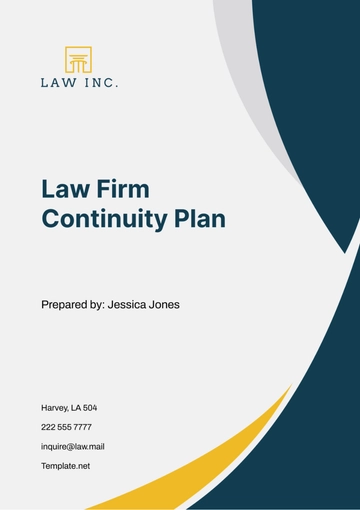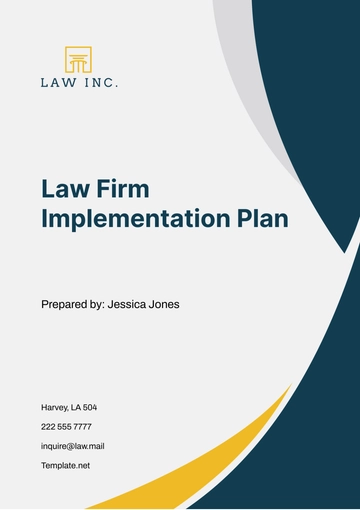Free Law Firm Growth Plan

I. Executive Summary
A. Overview of the Law Firm
Our law firm, [Your Company Name], was founded in [Year] and has since established itself as a reputable provider of legal services in [Location/Practice Area]. With a team of experienced attorneys and a commitment to client satisfaction, we have built a strong foundation for growth and success.
B. Summary of Objectives and Strategies
The primary objectives of this Growth Plan are to increase revenue, expand our client base, and enhance profitability. To achieve these goals, we will focus on market analysis, target audience identification, marketing strategy development, service expansion, client relationship management, and staff development. By implementing these strategies, we aim to position ourselves as a leading law firm in our target market and drive sustainable growth for the future.
II. Introduction
A. Background of the Firm
[Your Company Name] was founded with a mission to provide exceptional legal services and uphold the highest standards of integrity and professionalism. Over the years, we have earned the trust of our clients and established a reputation for excellence in [Practice Area/Location]. As we look to the future, we recognize the need to adapt to changing market dynamics and pursue strategic growth opportunities to remain competitive and fulfill our mission.
B. Purpose and Scope
The purpose of this Growth Plan is to outline our strategic approach to expanding our client base, increasing revenue, and enhancing profitability. It encompasses a comprehensive analysis of market trends, client needs, and competitive landscape, as well as specific strategies and action plans to achieve our growth objectives. By defining clear goals and implementing targeted initiatives, we aim to drive sustainable growth and ensure the long-term success of our firm.
C. Importance of Growth
In today's dynamic legal market, growth is essential for maintaining relevance and competitiveness. By expanding our client base and service offerings, we can capture new opportunities, mitigate risks, and strengthen our position in the market. Moreover, growth enables us to attract top talent, invest in technology and infrastructure, and better serve the evolving needs of our clients. Therefore, this Growth Plan is not just a strategic imperative but also a commitment to delivering value and driving positive outcomes for our firm, our clients, and our stakeholders.
III. Market Analysis
A. Overview of the Legal Market
The legal market in [Location/Practice Area] is characterized by regulatory changes, technological advancements, and shifting client preferences. These trends present both challenges and opportunities for law firms, as they reshape the competitive landscape and influence client demand for legal services.
B. Analysis of Competitors
Our competitors in the [Location/Practice Area] include [Competitor A], each with their own strengths and weaknesses. By analyzing their market positioning, service offerings, and client relationships, we can identify areas where we can differentiate ourselves and gain a competitive advantage.
C. Identification of Market Opportunities
Despite the challenges posed by competition and economic factors, there are significant opportunities for growth in [Location/Practice Area]. These opportunities include emerging industries, underserved market segments, and new legal needs, where we can leverage our expertise and capabilities to meet client demand and capture market share.
D. Assessment of Client Needs and Preferences
Clients in [Location/Practice Area] are increasingly seeking cost-effective solutions, specialized expertise, and personalized service. By understanding and addressing these needs, we can enhance client satisfaction, build long-term relationships, and differentiate ourselves from competitors in the market.
IV. Strategic Goals
A. Specific, Measurable Goals
Our strategic goals for growth are SMART—specific, measurable, achievable, relevant, and time-bound. These goals include increasing revenue by [00%] over the next [Timeframe], expanding our client base by [00%], launching [00] of new practice areas or niche specialties, and enhancing profitability through operational efficiency and cost management practices.
B. Short-term and Long-term Objectives
While our short-term objectives focus on immediate priorities and milestones, such as increasing market share or improving client retention, our long-term objectives are aimed at realizing our vision for sustained growth and market leadership. By setting clear goals and timelines for achievement, we can track our progress and stay focused on our strategic priorities.
C. Alignment with Mission and Values
Our growth objectives are aligned with our firm's mission to client advocacy, legal excellence, and community involvement. By staying true to our core values and principles, we can pursue growth opportunities that are consistent with our ethical standards and commitment to serving the best interests of our clients and communities.
V. Target Audience Identification
A. Definition of Ideal Client Personas
Our ideal clients include corporate executives, entrepreneurs, and individuals facing specific legal challenges. These clients value expertise, responsiveness, and cost-effectiveness, and they are seeking trusted legal advisors who can understand their unique needs and deliver tailored solutions.
B. Identification of Target Markets
We will target industries such as technology, healthcare, and real estate, as well as demographic segments such as millennials, baby boomers, and immigrant communities. By focusing our marketing and business development efforts on these target markets, we can maximize our reach and impact, and attract clients who are most likely to benefit from our services.
C. Analysis of Client Acquisition Channels
Key client acquisition channels include referrals, networking events, online search, and social media. By leveraging these channels effectively, we can reach prospective clients at various stages of their decision-making process, engage them with compelling messaging and value propositions, and convert leads into paying clients.
VI. Marketing Strategy
A. Comprehensive Marketing Plan
Our marketing plan encompasses a mix of digital and traditional marketing strategies, tailored to our target audience and growth objectives. These strategies include:
Strategy | Description |
|---|---|
Digital Marketing | We will enhance our online presence through a user-friendly website, SEO, PPC advertising, and social media marketing. |
Content Marketing | We will create high-quality content, such as blog posts, articles, and whitepapers, to demonstrate thought leadership and attract potential clients. |
Networking | We will participate in industry events, conferences, and networking groups to build relationships with potential clients and referral sources. |
Traditional Advertising | We will explore targeted advertising opportunities, such as print ads, radio spots, and sponsorships, to increase brand visibility in our local market. |
By implementing these strategies, we aim to increase brand awareness, generate leads, and drive conversions, ultimately contributing to our firm's growth and success.
VII. Service Expansion
A. Assessment of Current Service Offerings
Our current service offerings encompass a wide range of practice areas, including:
Corporate Law: Providing legal counsel on corporate governance, mergers and acquisitions, contract drafting and negotiation, and compliance matters.
Litigation and Dispute Resolution: Offering representation in civil litigation, commercial disputes, employment law matters, and alternative dispute resolution methods such as mediation and arbitration.
Real Estate Law: Handling transactions, lease agreements, property disputes, zoning issues, and land use planning for commercial and residential properties.
Family Law: Assisting clients with divorce, child custody, adoption, prenuptial agreements, and other family-related legal matters.
Intellectual Property: Protecting clients' intellectual property rights through patent, trademark, and copyright registration, licensing agreements, and enforcement actions.
While we have established expertise in these core practice areas, there are opportunities to expand our service portfolio to better serve our clients and capture new market opportunities.
B. Identification of Opportunities for Expansion
Key opportunities for service expansion include:
Employment Law: With the increasing complexity of labor regulations and workplace issues, there is growing demand for legal counsel in employment law matters, including wage and hour disputes, discrimination claims, and employee benefits.
Cybersecurity and Data Privacy: As businesses face heightened risks of data breaches and regulatory scrutiny, there is a growing need for legal expertise in cybersecurity compliance, data privacy regulations, incident response planning, and litigation related to data breaches.
Environmental Law: With growing concerns about climate change and sustainability, there is a rising demand for legal services in environmental law, including regulatory compliance, permitting, pollution mitigation, and environmental impact assessments.
Healthcare Law: Given the complex and rapidly evolving healthcare landscape, there is a need for legal counsel in healthcare law, including regulatory compliance, reimbursement issues, fraud and abuse investigations, and healthcare transactions.
Technology and Innovation Law: With the proliferation of technology startups and digital transformation across industries, there is a demand for legal expertise in technology and innovation law, including intellectual property protection, licensing agreements, venture capital financing, and technology transactions.
By leveraging our existing strengths and capabilities, we can develop new practice areas or niche specialties that align with market demand and client preferences.
C. Evaluation of Ancillary Services
In addition to core legal services, we will explore opportunities to offer ancillary services such as:
Mediation and Arbitration Services: Providing alternative dispute resolution services to clients seeking efficient and cost-effective resolutions to their legal disputes outside of the courtroom.
Consulting and Advisory Services: Offering strategic consulting and advisory services to businesses seeking guidance on legal, regulatory, and compliance issues impacting their operations and growth strategies.
Legal Technology Solutions: Partnering with legal tech companies to offer technology solutions that streamline legal processes, enhance efficiency, and improve client service delivery.
VIII. Client Relationship Management (CRM)
A. Implementation of CRM Systems and Processes
We will implement a robust CRM system to centralize client data, track interactions, and manage relationships effectively. This system will enable us to maintain a comprehensive view of client history, preferences, and communications, allowing us to deliver personalized service and anticipate client needs proactively.
B. Strategies for Enhancing Client Satisfaction
Key strategies for enhancing client satisfaction include:
Proactive Communication: We will establish clear communication channels and maintain regular contact with clients throughout their engagement with our firm. This includes providing updates on case progress, responding promptly to inquiries, and seeking feedback on our services to ensure alignment with client expectations.
Accessibility: We will ensure that clients can reach us easily and receive timely responses to their inquiries and concerns. This may involve offering extended office hours, providing multiple communication channels (such as phone, email, and online chat), and assigning dedicated client service representatives to address client needs promptly.
Quality Service: We are committed to delivering high-quality legal services that meet or exceed client expectations. This includes thorough legal analysis, strategic advice, and diligent representation tailored to each client's unique circumstances. By prioritizing excellence in service delivery, we aim to build trust and confidence with our clients, fostering long-term relationships based on mutual respect and satisfaction.
C. Encouragement of Repeat Business and Referrals
We recognize the importance of client loyalty and referrals in driving sustainable growth for our firm. To encourage repeat business and referrals, we will:
Deliver Exceptional Service: We will strive to exceed client expectations at every touchpoint, demonstrating our commitment to their success and satisfaction. By consistently delivering exceptional service, we aim to earn clients' trust and loyalty, encouraging them to return to us for future legal needs and recommend our firm to others.
Request Referrals: We will actively solicit referrals from satisfied clients, asking them to recommend our services to their network of contacts. This may involve formal referral programs, incentives for successful referrals, and ongoing communication to remind clients of our appreciation for their referrals.
Maintain Ongoing Relationships: We will stay engaged with past clients even after their matters are resolved, maintaining regular communication through newsletters, client appreciation events, and other outreach initiatives. By staying top-of-mind with past clients, we increase the likelihood of receiving repeat business and referrals, while also fostering a sense of loyalty and goodwill within our client community.
IX. Staffing and Talent Development
A. Evaluation of Staffing Needs
We will conduct a comprehensive assessment of our current staffing levels and capabilities, identifying any gaps or areas for improvement. This assessment will inform our recruitment and hiring strategies, ensuring that we have the right talent in place to support our growth initiatives and deliver exceptional service to our clients.
B. Recruitment Strategies
Our recruitment efforts will focus on attracting experienced attorneys, paralegals, and support staff who share our firm's values and commitment to excellence. We will utilize a combination of recruitment channels, including job boards, professional networks, referrals, and recruitment agencies, to identify qualified candidates who align with our firm culture and strategic objectives.
C. Training and Development Programs
We are committed to investing in the ongoing professional development of our staff, providing opportunities for training, mentorship, and career advancement. We will develop customized training programs to enhance staff skills and competencies, equipping them with the knowledge and resources needed to excel in their roles and contribute to the firm's growth and success.
D. Retention Strategies
To retain top talent and reduce turnover, we will implement retention strategies focused on fostering a supportive and inclusive work environment, recognizing and rewarding employee contributions, and promoting work-life balance and employee well-being. By prioritizing staff engagement and satisfaction, we aim to create a positive workplace culture where employees feel valued, motivated, and empowered to achieve their full potential.
X. Technology Integration
A. Adoption of Technology Solutions
We will invest in cutting-edge technology solutions to streamline our internal processes, automate routine tasks, and optimize workflow efficiency. This may include practice management software, document management systems, e-discovery tools, and cloud-based collaboration platforms, designed to enhance productivity and mitigate risk.
B. Enhancement of Client Communication
Technology will play a crucial role in improving client communication and collaboration, enabling us to provide timely updates, share documents securely, and facilitate virtual meetings and consultations. We will leverage client portals, secure messaging platforms, and video conferencing tools to enhance the client experience and accommodate their preferences for remote interaction.
C. Investment in [Second Party]
We will stay abreast of emerging trends and innovations in legal technology ([Second Party]), exploring opportunities to integrate new tools and solutions into our practice. This may include artificial intelligence (AI) for legal research and contract analysis, predictive analytics for case outcomes, and blockchain technology for secure document management and authentication.
D. Training and Adoption Initiatives
To ensure successful implementation and adoption of technology solutions, we will provide comprehensive training and support to our staff, equipping them with the knowledge and skills needed to leverage technology effectively in their daily work. We will also establish protocols and best practices for data security, privacy, and compliance, to protect client confidentiality and maintain trust and confidence in our firm.
XI. Financial Management
A. Development of a Budget
We will develop a detailed budget that aligns with our growth objectives and strategic priorities, allocating resources strategically to support key initiatives and maximize return on investment. The budget will encompass operating expenses, marketing expenditures, technology investments, and staffing costs, as well as provisions for contingencies and unforeseen expenses.
B. Financial Projections
We will prepare financial projections based on various growth scenarios and assumptions, forecasting revenue, expenses, and profitability over the planning period. These projections will serve as a roadmap for tracking our progress and evaluating the financial viability of our growth strategies, enabling us to make informed decisions and adjustments as needed.
C. Monitoring of Key Performance Indicators (KPIs)
We will establish key performance indicators (KPIs) to track our progress towards our growth objectives and measure the effectiveness of our strategies and initiatives. These KPIs may include metrics such as revenue growth, client acquisition rates, client satisfaction scores, billable hours, and profitability margins, providing valuable insights into our firm's financial health and performance.
D. Regular Evaluation and Adjustment
We will conduct regular reviews and evaluations of our financial performance, comparing actual results against budgeted targets and KPI benchmarks. Based on these assessments, we will identify areas of strength and opportunities for improvement, adjusting our strategies and resource allocations as needed to optimize financial outcomes and achieve our growth objectives.
XII. Implementation Plan
A. Actionable Steps
We will break down each growth strategy into specific tasks and action items, outlining the sequence of activities needed to achieve our objectives. These steps will include tasks such as market research, website development, content creation, staff training, and client outreach, among others, with clear deadlines and milestones for completion.
B. Assignment of Responsibilities
We will designate responsible individuals or teams for each task or action item, ensuring accountability and effective coordination throughout the implementation process. Key stakeholders, including attorneys, department heads, marketing professionals, IT staff, and administrative personnel, will be assigned roles based on their expertise and availability.
C. Resource Allocation
We will allocate resources, including human, financial, and technological resources, to support the implementation of our growth strategies. This may involve reallocating existing resources, securing additional funding or staffing as needed, and prioritizing investments based on their impact on achieving our growth objectives.
D. Timeline Development
We will develop a detailed timeline or project plan outlining the sequence of activities, deadlines, and dependencies for each phase of the implementation process. This timeline will serve as a roadmap for tracking progress, identifying potential bottlenecks or delays, and ensuring that we stay on track to achieve our goals within the specified timeframe.
XIII. Monitoring and Evaluation
A. Establishment of Metrics
We will establish key performance indicators (KPIs) and benchmarks to measure our progress towards our growth objectives. These metrics may include financial indicators such as revenue growth, profitability margins, and client acquisition rates, as well as operational metrics such as staff productivity, client satisfaction scores, and marketing ROI.
B. Regular Review Process
We will conduct regular reviews and evaluations of our performance against established KPIs and benchmarks, analyzing trends, identifying variances, and assessing the effectiveness of our strategies and initiatives. These reviews may occur monthly, quarterly, or annually, depending on the nature and scope of our growth plan.
C. Feedback and Adjustment
Based on our performance reviews and analysis, we will identify areas of success and opportunities for improvement, making adjustments to our strategies, tactics, and resource allocations as needed. This iterative process of feedback and adjustment will enable us to adapt to changing market conditions, capitalize on emerging opportunities, and overcome challenges more effectively.
XIV. Conclusion
A. Recap of Key Objectives and Strategies
In conclusion, the Law Firm Growth Plan outlines our strategic approach to expanding our client base, increasing revenue, and enhancing profitability. By focusing on market analysis, target audience identification, marketing strategy development, service expansion, client relationship management, and staff development, we aim to achieve our growth objectives and position ourselves as a leading provider of legal services in our target market.
B. Commitment to Growth
Our firm is committed to the pursuit of growth and excellence, guided by our core values of integrity, professionalism, and client-centered service. We recognize that growth is essential for maintaining relevance and competitiveness in today's dynamic legal landscape, and we are dedicated to investing in the resources, talent, and strategies needed to achieve our goals and fulfill our mission.
C. Importance of Collaboration
We understand that achieving our growth objectives requires collaboration and teamwork across all levels of our organization. We are grateful for the dedication and contributions of our staff, clients, and stakeholders, and we look forward to working together to realize our vision for success.
- 100% Customizable, free editor
- Access 1 Million+ Templates, photo’s & graphics
- Download or share as a template
- Click and replace photos, graphics, text, backgrounds
- Resize, crop, AI write & more
- Access advanced editor
Utilize the Law Firm Growth Plan Template from Template.net to accelerate your firm's success. This editable and customizable template offers a comprehensive roadmap for expansion, enhanced by an intuitive AI Editor Tool. Achieve strategic objectives with ease, capitalize on market opportunities, and stay ahead of the competition with this indispensable resource.
You may also like
- Finance Plan
- Construction Plan
- Sales Plan
- Development Plan
- Career Plan
- Budget Plan
- HR Plan
- Education Plan
- Transition Plan
- Work Plan
- Training Plan
- Communication Plan
- Operation Plan
- Health And Safety Plan
- Strategy Plan
- Professional Development Plan
- Advertising Plan
- Risk Management Plan
- Restaurant Plan
- School Plan
- Nursing Home Patient Care Plan
- Nursing Care Plan
- Plan Event
- Startup Plan
- Social Media Plan
- Staffing Plan
- Annual Plan
- Content Plan
- Payment Plan
- Implementation Plan
- Hotel Plan
- Workout Plan
- Accounting Plan
- Campaign Plan
- Essay Plan
- 30 60 90 Day Plan
- Research Plan
- Recruitment Plan
- 90 Day Plan
- Quarterly Plan
- Emergency Plan
- 5 Year Plan
- Gym Plan
- Personal Plan
- IT and Software Plan
- Treatment Plan
- Real Estate Plan
- Law Firm Plan
- Healthcare Plan
- Improvement Plan
- Media Plan
- 5 Year Business Plan
- Learning Plan
- Marketing Campaign Plan
- Travel Agency Plan
- Cleaning Services Plan
- Interior Design Plan
- Performance Plan
- PR Plan
- Birth Plan
- Life Plan
- SEO Plan
- Disaster Recovery Plan
- Continuity Plan
- Launch Plan
- Legal Plan
- Behavior Plan
- Performance Improvement Plan
- Salon Plan
- Security Plan
- Security Management Plan
- Employee Development Plan
- Quality Plan
- Service Improvement Plan
- Growth Plan
- Incident Response Plan
- Basketball Plan
- Emergency Action Plan
- Product Launch Plan
- Spa Plan
- Employee Training Plan
- Data Analysis Plan
- Employee Action Plan
- Territory Plan
- Audit Plan
- Classroom Plan
- Activity Plan
- Parenting Plan
- Care Plan
- Project Execution Plan
- Exercise Plan
- Internship Plan
- Software Development Plan
- Continuous Improvement Plan
- Leave Plan
- 90 Day Sales Plan
- Advertising Agency Plan
- Employee Transition Plan
- Smart Action Plan
- Workplace Safety Plan
- Behavior Change Plan
- Contingency Plan
- Continuity of Operations Plan
- Health Plan
- Quality Control Plan
- Self Plan
- Sports Development Plan
- Change Management Plan
- Ecommerce Plan
- Personal Financial Plan
- Process Improvement Plan
- 30-60-90 Day Sales Plan
- Crisis Management Plan
- Engagement Plan
- Execution Plan
- Pandemic Plan
- Quality Assurance Plan
- Service Continuity Plan
- Agile Project Plan
- Fundraising Plan
- Job Transition Plan
- Asset Maintenance Plan
- Maintenance Plan
- Software Test Plan
- Staff Training and Development Plan
- 3 Year Plan
- Brand Activation Plan
- Release Plan
- Resource Plan
- Risk Mitigation Plan
- Teacher Plan
- 30 60 90 Day Plan for New Manager
- Food Safety Plan
- Food Truck Plan
- Hiring Plan
- Quality Management Plan
- Wellness Plan
- Behavior Intervention Plan
- Bonus Plan
- Investment Plan
- Maternity Leave Plan
- Pandemic Response Plan
- Succession Planning
- Coaching Plan
- Configuration Management Plan
- Remote Work Plan
- Self Care Plan
- Teaching Plan
- 100-Day Plan
- HACCP Plan
- Student Plan
- Sustainability Plan
- 30 60 90 Day Plan for Interview
- Access Plan
- Site Specific Safety Plan





























